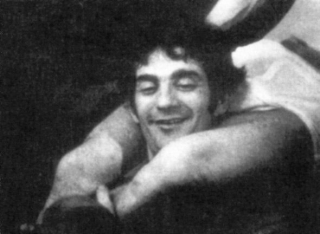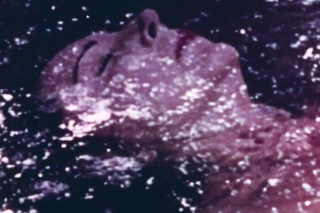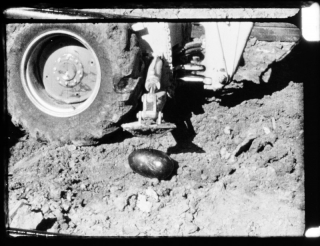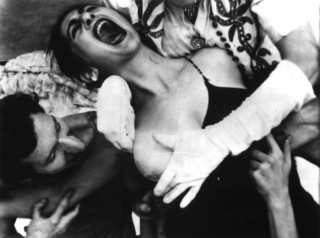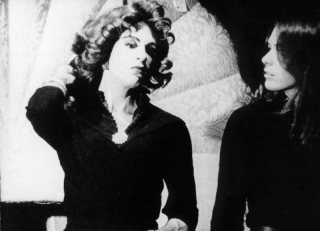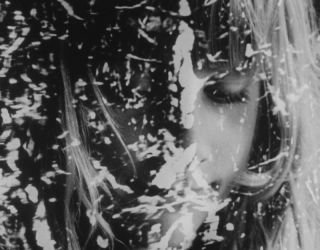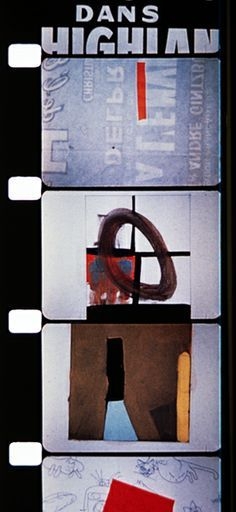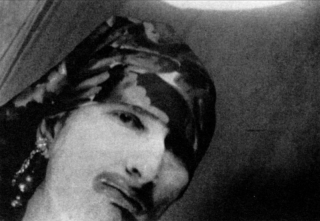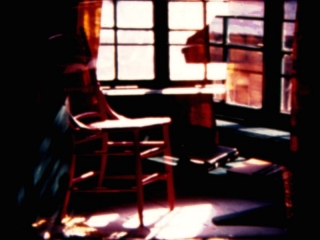This programme looks at the Beat movement’s influence on cinema. We begin with the UK premiere of the only film work by the often overlooked artist Wallace Berman. The writer Jack Kerouac wrote and narrated Pull My Daisy starring Allen Ginsberg, Gregory Corso and Larry Rivers. This film and John Cassavettes’ Shadows marked a turning point for the New American Cinema. Also included are two works by collagist Bruce Conner, an early appearance by one of the underground’s true stars – Taylor Mead in the Hollywood satire To L.A. With Lust – and Robert Nelson’s hilarious Oh! Dem Watermelons. Paperdolls includes photography by the legendary Jack Smith, and Warren Sonbert shows bohemian life in the New York of the 60s.
THE BEATS
Saturday 24 October 1998, at 3:30pm
London Barbican Cinema
The Beat Movement, which was most evident through the 1950’s, is primarily known for its literature and the works of Jack Kerouac, Allen Ginsberg and William S. Burroughs. However, diverse artists in the fields of performance, painting, sculpture, music and film also shared the Beat sensibility. Kerouac and Ginsberg were both directly involved in the production of Pull My Daisy (1957) and Burroughs engaged in most of the artistic disciplines in his lifetime and collaborated on films with Anthony Balch and Brion Gysin (notably Towers Open Fire, 1963 and The Cut-Ups, 1967).
Wallace Berman was in many ways an archetypal Beat artist, who worked for years in relative obscurity on assemblage, collage and painting. Between 1955 and 1964 he published Semina, a hand-printed, makeshift poetry journal. In 1957, during his only exhibition at a commercial gallery, the artist was arrested and the show was closed down by the LAPD over a painting by Cameron, the star of Kenneth Anger’s Inauguration of The Pleasure Dome (1954-66), which was incorporated into one of Berman’s sculptures. By 1964 he was using an early copy machine called the Verifax to make substantial and important collages. Berman was also a leading pioneer of mail art. For a decade from 1956, he worked on his only film which was for a while called Semina but is now known as Untitled. The film was never shown to a large or paying audience – Wallace Berman was interested primarily in presenting his work on a one-to-one basis. It is essentially a collection of images that were collected around Berman’s studio, shot on black and white 8mm film and later hand-tinted in red ink. Wallace had an undeniable, though widely unrecognised, influence on popular culture and as a result was selected by Peter Blake to appear on the cover of The Beatles’ Sgt Pepper album and was cast by Dennis Hopper in a scene of Easy Rider. He died in 1976, leaving an important body of work that should now be reassessed.
UNTITLED
Wallace Berman, USA, 1956-66, 16mm, colour, silent, 7 min
“Untitled has its own essence of narrative that may or may not be there. Like the dance – it is more of a meditation than a factual report. Wallace was an informant in his artwork, not of the concrete flesh, but in its ‘unknown’ undertone that reads the music in (on) the air – frozen by a hand, holding the sound image in a transistor radio. The images indicate a twisting of the radio dial; turning singular visions off and on. There are those who detach film from other artworks – that is a conventional mistake – essentially when it concerns this work. All the dominant themes in my father’s work – death, life, mysticism, politics, pop culture – are in this film. To exclude the cinematic version of his artwork would be an act of folly. The film’s brilliance is that it captures the period so clearly with Wallace’s exhilarating mood of rapid changes within his art, in that transition from the mid-1950s to the 1960s – in addition to my father’s intimate life during that time. Besides, the film is extraordinary as a work of art.” (from Wallace And His Film by Tosh Berman in the book Support The Revolution, 1992)
What is regarded by many people as the most accurate cinematic depiction of the Beat movement was developed from a play by Jack Kerouac entitled The Beat Generation Or The New Amaraean Church. The third act was chosen by Kerouac, Robert Frank and Alfred Leslie to form the basis of the film Pull My Daisy in 1957. Alfred Leslie was an Abstract Expressionist painter and Robert Frank a photographer who was to become well known a year later on publication of his book The Americans. What appears to be a casual and instantaneous encounter was actually a carefully rehearsed and controlled work. The film was mostly shot in Leslie’s studio loft and stars Allen Ginsberg, Peter Orlovsky, Gregory Corso and Larry Rivers. The soundtrack is a loose narration improvised by Kerouac with musical accompaniment by David Amram. It was premiered in 1959 alongside John Cassavetes’ similarly ground-breaking feature Shadows (1959), a screening that was a landmark in the New American Cinema. Pull My Daisy was financed by Walter Gutman, a Wall Street banker who developed an interest in experimental movies and went on to create a series of extraordinary films usually depicting his interest in nubile young circus girls.
PULL MY DAISY
Robert Frank & Alfred Leslie, USA, 1957, 35mm, b/w, sound, 27 min
“A spoof on the Beat Generation, a nonsense comedy, it blends most perfectly the elements of improvisation and conscious planning, both in camera work and directing. The plotless episode has never been more eloquent than it is in this film. The feeling of “being there” was achieved in this fiction film to the highest degree. Its authenticity is so effective, its style so perfect, that the film has fooled even some very intelligent critics: They speak about it as if it where a slice-of-life film, a piece cut out of the raw stream of life, a documentary. Instead of criticising the film, they criticise the Beat Generation. The film’s amazing sense of style and form escapes through their fingers like fluid – it is almost invisible, transparent. No other film ever said so much, and in such a pure and condensed manner, about the man of the Beat Generation.” (Jonas Mekas’ Notes On The New American Cinema in Film Culture #24, 1962)
Christopher Maclaine was a poet and bohemian who worked with a dedication to madness, and was regarded by many as the Artaud of San Francisco. As a filmmaker he documented the Beat movement as it happened. He completed only four films, including an epic called The End (1953) – a dark apocalyptic chronicle of obsession, despair, murder and suicide. Beat, by contrast, is a witty and graceful portrait of the time. Maclaine’s continued use of amphetamines led to rapid physical and mental deterioration and after a suicide attempt in 1963 he spent most of the remainder of his life in a vegetable state until he died in 1975.
BEAT
Christopher Maclaine, USA, 1958, 16mm, colour, sound, 6 min
“As one looks at his film Beat one sees more of the humour in his camera movements. People are made to walk fast and look jerky in his films, and this is intentional humour; he was not content to shoot at eight frames per second – he skips frames so that people skip ridiculously in a way that rhythmically captures their intrinsic self-centredness. No more perfect metaphor for street life in North Beach at that time could be found than the woman in Beat who behaves as though she were free and lovely (with an umbrella – she is Gene Kelly singing in the rain). But she is like a turtle trapped in a cage, going around the four corners of an intersection. One can look at this as humorous or as unbearably horrible. If you can regard it as both delightful and horrifying, you are close to the balance that makes Maclaine an artist. To me, Beat evokes that era to a T – beautifully, precisely, wittily and terrifyingly.” (description by Stan Brakhage in his book Film At Wit’s End, 1989)
Bruce Conner is widely regarded as one of the masters of experimental cinema, and he is unique in that he rarely shoots his own material, preferring to montage found or stock footage. He was a leading assemblage artist and this, his first film, was originally conceived as a loop forming part of a sculpture. In constructing A Movie, Conner developed a new style of film-making in which material from different sources was edited together so that a continuity is suggested where it cannot plausibly exist.
A MOVIE
Bruce Conner, USA, 1958, 16mm, b/w, sound, 12 min
“Using only found footage, Conner has created one of the most extraordinary films ever made. One begins by laughing at the juxtaposition of Cowboys and Indians, elephants and tanks, but soon the metaphor of association becomes serious, as we realise we are witnessing the apocalypse.” (Freude on A Movie, Canyon Cinema Catalogue #7, 1992)
To L.A. With Lust features an early appearance by one of the underground’s true stars – Taylor Mead, who collaborated on two films with the director Vernon Zimmerman. A year earlier the pair had made Lemon Hearts (1960) in the decaying Victorian mansions of San Francisco, and it was here that Mead first displayed his onscreen comic persona (which is not dissimilar to real life). Whilst technically crude and primitive, it is a film of liberation which prefigured the work of Ron Rice, Ken Jacobs and Jack Smith. Their second movie To L.A. With Lust is a funky and wonderful satire on Hollywood.
TO L.A. WITH LUST
Vernon Zimmerman, USA, 1961, 16mm, b/w & colour, sound, 27 min
“Wild and dirty, but so easy to understand, comparatively speaking, that it may be considered a fair introduction to cinematic youth on-the-march. It has distinct traces of humour, no thanks to Zen, and offers several moments of pleasure. The female star, Ingrid Lothigius, is a blonde who photographs well and deadpans her life and hard times like a pro.” (Archie Winston reviews To L.A. With Lust in the New York Post, early 1960s)
In 1961 Bruce Conner substantially speeded up the method of quick cutting that he had presented in A Movie three years before. In Cosmic Ray a stripper is rapidly juxtaposed with images such as cannons, fireworks and phallic symbols until a final climactic release is achieved. The frenzied rate of images attracted the attention of advertising executives and is thought to have influenced the development of fast cutting in commercial television. Conner continued to develop his montage technique and his last two completed works (in 1979 and 1981), which accompany tracks by Devo and David Byrne, may be regarded as innovative music videos.
COSMIC RAY
Bruce Conner, USA, 1961, 16mm, b/w, sound, 4 min
“Cosmic Ray used to get rented by advertising agencies … So in a way, I might be guilty of some of that tendency in ads to get as much information as possible into a short period of time. I’m aware of the way that people are manipulated by television advertising, so much so that I can’t stand to watch the stuff. It’s not just the manipulation in the commercials, it’s the manipulation in the programming itself that gets to me. Most of it is nasty and aggressive, and I take it as a personal assault. I couldn’t kill my TV set just by kicking it; I had to use a hammer. That’s dangerous. Electricity is stored inside TV sets, so even when they’re unplugged, there’s enough power to electrocute you.” (Bruce Conner in conversation with Scott MacDonald in 1981, from the book A Critical Cinema, 1988)
Richard Preston is best known for his cut-and-paste animation of magazine illustrations that satire the social and political aspects of American life. Sometime in 1961 Preston printed a number of black and white photographic tableaus for Jack Smith and these were filmed and interspersed with images of nude pin-ups from girlie magazines to form Paperdolls.
PAPERDOLLS
Richard Preston, USA, 1962, 16mm, colour, sound, 5 min
“I have been in the pillory for years, but now, with the aid of film I have managed to wriggle one arm free. With this good arm I can catch and hurl back some of the garbage that has been thrown at me. And by garbage I mean the lies, the distortions, the hypocrisies that are the manipulators’ weapons.” (Richard Preston in the Film-Makers Lecture Bureau Catalogue #1, 1969)
Robert Nelson has made films in a variety of styles but each are underpinned by an enthusiastic, deeply felt sense of humour. After studying at San Francisco Art Institute, Nelson became immersed in the beatnik culture around him. His early films are anarchic comedies and Oh! Dem Watermelons (1965) is a riotous underground masterpiece. It was originally conceived to form part of the San Francisco Mime Troupe’s Minstrel Show – a shocking confrontation of the racism inherent in American culture. After a frustratingly long opening shot the film careers through a rapid anthology of events covering just about every possible abuse of a watermelon. Later works by Nelson display a more subtle use of humour and his classic Bleu Shut (1970) is a participatory film in which the audience is tested in an absurd kind of TV quiz show.
OH! DEM WATERMELONS
Robert Nelson, USA, 1965, 16mm, colour, sound, 12 min
“The film cost $280 to make, including the cost of a dozen watermelons. We all had a good time running around the Mission District and Portrero Hill busting up watermelons, showing-off and having fun. A few weeks later when we had the film roughly edited, I ran it silent for Ron and Saul and a few people at the Mime Troupe. There was deadly silence and it looked awful. Everyone was embarrassed for me and didn’t know what to say. I faked it by saying it was good and not to worry. A few days later Steve Reich composed the soundtrack and got all the people to sing their parts the right way. The track has helped the film a lot. The film has won a lot of prizes all over the world … and I bought a lot of equipment with the prize money I got for it.” (Robert Nelson On Robert Nelson in Film Culture #48-49, 1970)
Whilst from a later era and not strictly Beat, Warren Sonbert’s romantic diary films chronicle the lives of young, swinging bohemians in New York in the late sixties. His first film Amphetamine (1966) centres around two homosexuals who share a predilection for shooting speed, but it is not a shocking expose – like his other works it is a beautiful and sensitive piece of cinema. Together with Where Did Our Love Go and Hall Of Mirrors (both also from 1966) it forms a potent trilogy depicting the lives of the filmmaker and his friends. In the 1970s, Sonbert began to restructure his earlier footage into silent films such as his magnum opus Carriage Trade (1968-72). He died in 1995 and his entire catalogue has recently been restored by The Estate Project and will receive a major retrospective at the Guggenheim Museum in 1999.
AMPHETAMINE
Warren Sonbert, USA, 1966, 16mm, b/w, sound, 10 min
“And the films themselves were sexy. I don’t mean to say that the actors took their clothes off, they didn’t, but what was sexy was the extremely fluid way the movies were put together. The soundtrack of soul songs had something to do with it, but even more so the long hand-held tracking shots that followed in “real time” someone walking down corridor after corridor, or the merry-go-round shot that metaphorically described an attitude toward the cosmos as much as did Godard’s swirling coffee cup. The shots took over us like a wet dream. It was as if Hitchcock’s 360-degree turn around the lovers, Stewart and Novak, in Vertigo, that saturation of love and impossible yearning and doubt and fulfilment, had started to infiltrate all of Sonbert’s images. It was a lover’s cinema. The film-maker was in love with the world, or was amused and saddened by it, so obviously that he had only to point his camera anywhere, it seemed, and it would fill up with feeling.” (Philip Lopate on The Films Of Warren Sonbert in Film Culture #70-71, 1983)
PLEASE NOTE A CHANGE TO THE ADVERTISED PROGRAMME
The Warren Sonbert film Amphetamine has not yet arrived from California. It has been replaced in this afternoon’s programme by How Can We Tell The Dancer From The Dance ? by Jerry Joffen (1970, 10 min).
Back to top
